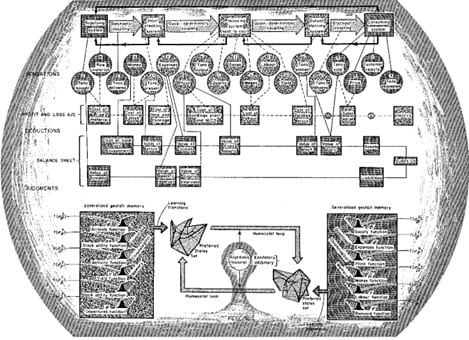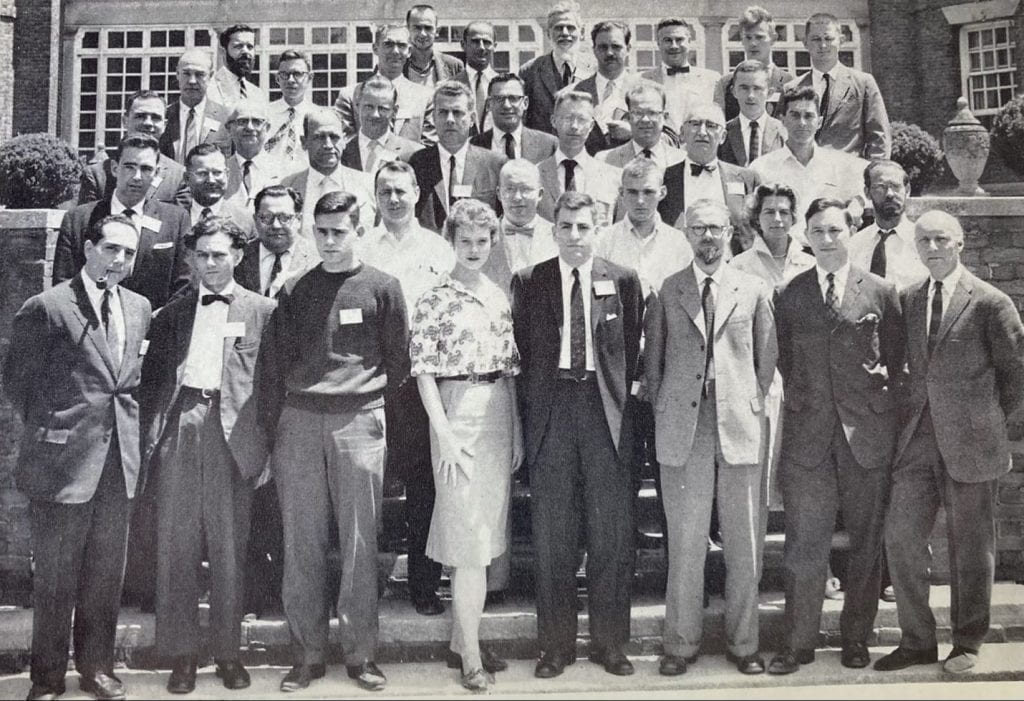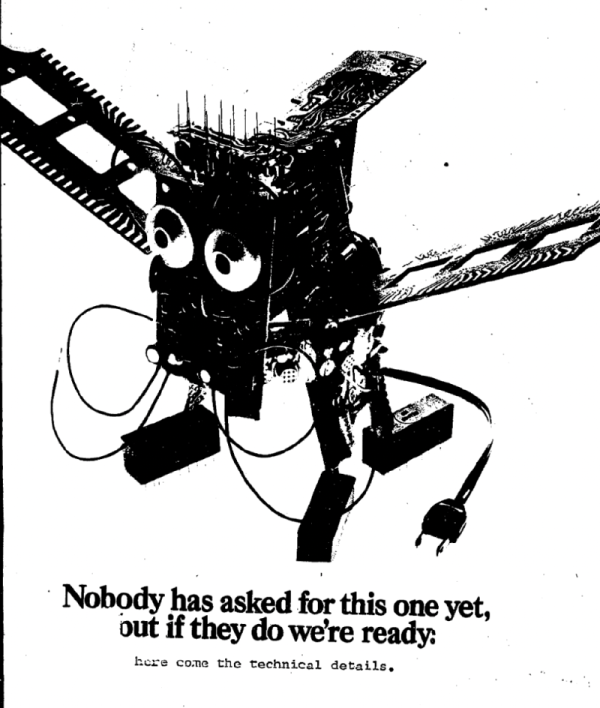By Maxfield Hancock
Daphnia, better known as water fleas, are aquatic crustaceans ranging from 1 to 5 millimeters in length. They dwell in open bodies of fresh water on every continent except Antarctica. In 1962, the left-wing systems theorist and operations researcher Stafford Beer discovered that Daphnia possess an aversion to “tiny magnets.”
How did Beer arrive at this conclusion? First, Beer had transplanted a colony of Daphnia to a fish tank and given the creatures dead leaves to eat. Next, he snuck iron filings small enough for Daphnia to ingest into the leaves. Beer waited until the Daphnia had swallowed these iron pieces, then placed the aquarium in an electromagnetic field. Beer planned to read out changes in the electrical characteristics of the phase space produced by the colony’s spontaneous response to the electromagnetic charge. “However,” Beer was forced to admit, “there were many experimental problems. The most serious of these was the collapse of any incipient organization – apparently due to the steadily increasing suspension of tiny permanent magnets in the water.”[1] Beer’s crustaceans excreted magnetized iron filaments into their surroundings faster than Beer could fool them into swallowing more iron.
These Daphnia were unwilling participants in a project which had commenced two years prior at the “1960 Symposium on the Principles of Self Organization,” hosted by the Biological Computer Laboratory (BCL) at the University of Illinois. The symposium drew a coterie of engineers and social theorists with a shared interest in the emergent properties of complex systems to the grounds of a Gilded Age mansion on the outskirts of Champaign. That weekend, Stafford Beer delivered a presentation which was attended by none other than Friedrich Hayek, the fabled Austrian economist, who had taken the train down from his post at the University of Chicago. Beer, the central planner, and Hayek, a free marketeer par excellence, left remarkably positive first impressions on one another.
The centerpiece of Beer’s presentation was the schematic of a fully automated “lights-out factory.” Automating the factory floor was all well and good, however Beer argued that to survive in a competitive market environment, the automatic factory would require a brain:
When men have been almost eliminated from the factory, and it runs smoothly and efficiently by automatic regulation, error-controlled feedback, and programmed response to a specified and limited variety of situations, we have the living organism of the company as the analog of, say, an animal whose nervous system stops at the cerebellum… This will not do. The spinal dog is short of a built-in cerebrum; and the automatic factory is short of a built-in brain. The research discussed in this paper is directed towards the creation of a brain artefact capable of running the company under the evolutionary criterion for survival (p. 27-28).
Cue crustaceans. “The most valuable lead in my own mind,” Beer continued, “concerns the use of organic systems. I now speak boldly of animals themselves” (p. 76). Beer stipulated that engineering a suitable brain would require harnessing the factory to a homeostatic colony of animal life. In a 1962 “Progress Note” which Beer distributed to the symposium’s attendees, he elaborated: “I was led to consider various kinds of animal… Rats and pigeons have both been closely studied for their learning attributes, both as individuals and as groups. By the same token, bees, ants, termites, have all been systematically considered as components of self-organizing systems.” (p. 29). Beer’s objective was to marshal the emergent, self-organizing properties of living things to create a strange, new type of device.

Beer’s “brain artefact” would make high-level production decisions in the context of the automatic factory. In Beer’s scheme, a colony of living things receives a signal (a particular electromagnetic charge, in the case of Daphnia) which encodes the sum of the information available to factory owners and entrepreneurs. The control mechanism transmutes economic data into sense data. The creatures’ spontaneous response to changes in the market, which they perceive as changes occurring in their environment, determines the ‘behavior’ of the automatic factory.
Beer’s economic control mechanism creates a feedback loop that “sets up a homeostatic relationship between the controller and the world” (p. 26). Through trial and error, Beer believed that it was possible at scale to train homeostatic control mechanisms to achieve specific distributive justice outcomes, including socialism. In an interview with Eden Medina, Beer’s colleague Hermann Schwember doubted the engineer’s Marxist credentials. Schwember disclosed that Beer’s influences were Trotsky and Trotskyites (p. 262). Nevertheless, Beer shared in a 2001 interview, “politically, I was always left. I was a socialist and still am” (p. 61). Karl Marx had quipped that “a bee puts to shame many an architect in the construction of her cells. But what distinguishes the worst architect from the best of bees is this, that the architect raises his structure in imagination before he erects it in reality.” Beer believed in the possibility of administering a futuristic socialist command economy but saw that it would require relegating essential tasks to the bee.
Beer’s presentation provoked strong feelings (“Your brain, it seems, has no religion,” a doctor in attendance protested, “You did say at one point the whole thing was only for survival, or homeostasis, but does it want to be evil or good?”) (p. 84). But perhaps no attendee was quite so dazzled by Beer’s ideas as Hayek. The same evening that Beer presented his research, he wrote in his diary that “I was most gratified by the reaction of that eminent economist, Dr. Hayek, who thinks that this approach to the economic structure and control of industrial companies is a revelation compared with the classical modes of analysis” (295).
In a letter addressed to the BCL’s director, Heinz von Foerster, in the months prior to the Illinois symposium, Hayek agreed to deliver a presentation titled “Higher Level Regularities.”[2] Hayek pulled his presentation from the schedule at the last minute, citing health issues (“I was in the beginning of a curious ‘illness,’” he confessed in a letter to von Foerster in 1962, “What happened was that I had suddenly stopped smoking a few days before the conference… twelve months later, I resumed smoking. I am now as fit as ever.”).[3] Thankfully, Hayek clarified what he meant by “higher level regularities” in a talk he delivered four months following the Illinois symposium to the economics faculty at the University of Virginia. Hayek spoke at length about patterns that emerge from relations between people that are not the result of human design. In the case of certain highly complex phenomena, “all we are able to do is speak about the kind of pattern that will form itself, about a pattern that is defined by certain characteristics or attributes, without being able to specify the detail. I shall say,” Hayek continued, “that all we know in such instances are certain ‘higher level regularities’” (p. 381). The characteristics which Hayek alludes to belong to the state of affairs in a market economy in which prices correspond to costs – a pattern which organizes itself.

Hayek and Beer were both committed to applying the principles of self-organization to economic institutions. Both men believed that the blossoming of human liberty would require a self-organizing material and, per Quinn Slobodian, a world-spanning framework to encase it. But the very same emergent properties which became the foundation of Beer’s vision for the future of economic planning inspired Hayek’s case against command economies. Beginning in the 1930s, Hayek argued that the market’s emergent properties equipped economists with a knock-down case against central planning. The dispersal of knowledge in society is so complete, Hayek wrote in a series of key articles, and the mechanism by which order emerges from discrete transactions is so opaque that it is not possible to possess a functional overview of the economy. Ergo, rational economic planning is an oxymoron, and socialists cannot hope to replicate the wisdom of the price mechanism.
Hayek’s path crossed Beer’s a second time, out of joint, in Chile in the 1970s. Beer is famed for engineering socialist Chile’s CYBERSYN project (Eden Medina published the authoritative work on the subject in 2011). From 1971 until 1973, Beer served in President Allende’s cabinet, tasked with coordinating central economic planning. In 1973, a military junta led by General Augusto Pinochet seized power, destroyed Beer’s planning apparatus, and imprisoned some of his colleagues. Not long after, in 1977, Hayek embarked on a goodwill tour of Pinochet’s Chile to pose for photos with the general and give his imprimatur to a starkly different model of self-organization: the new regime’s no-holds-barred, ‘Chicago Boys’ monetarism.
The 1969 Mansfield Amendment prohibited the Defense Department from funding “inessential” research, and in the years that followed, bio-cybernetics institutes such as the BCL met the fate of Beer’s Daphnia, victims of their own waste. But Beer remained wed to the principles of self-organization for the remainder of his career. Self-organization became the foundation of the “Viable Systems Model” which Beer developed for use in Chile and later pitched to leftist governments in Uruguay, Venezuela, and Mexico. Self-organization was attractive to Beer and Hayek because the economy struck both men as a poor fit for the social sciences’ classical, cause-and-effect mode of explanation. Beer and Hayek both argued that the economy displays an order superordinate to its parts and that it consequently “defies analysis.” (p. 25). Neither believed it possible to possess complete knowledge of the economy’s component parts and laws of motion. To make truth claims about the economy, Hayek and Beer made claims about the order that patterned the economy’s emergent properties (its “higher level regularities”) and the smaller and larger orders that it resembled. Classical analysis requires causes and effects, which may be impossible to ascertain. All that self-organization requires is resemblance. Self-organization rejected cause-and-effect in favor of microcosm-and-macrocosm, braiding the economy, cognition, and the homeostatic properties of biological life.
In self-organization’s chain of resemblance, individual members of our species take priority over every other link. The printed transactions of the 1960 symposium include a foreword: “The large disparity between present accomplishments and possible future achievement by more man-like systems, should give the engineer an urgent concern for the subject matter of this Symposium” (p. v). In 1973, Beer delivered the Canadian Broadcasting Corporation’s prestigious annual Massey Lectures. On air, he advocated for a world economy “that works like our own bodies.” And that same year, scarcely two weeks after General Pinochet seized power, Heinz von Foerster sent Beer a telegraph which drew an analogy between the collapse of CYBERSYN and the recent death of von Foerster’s dear friend and colleague, Ross Ashby. “My dear Stafford, when our Ross died you cabled: ‘Our Ross is dead. Let us celebrate whatever immortality may mean.’ Your words are in my mind ever since our Chile died. Let us mourn mortality for what it is.”[4] Beer never subordinated the national economy to a colony of living things. But Beer and Hayek both felt deeply that the stakes of running an economy which works like our own bodies were life and death.
[1] Heinz von Foerster to Stafford Beer, 23 September 1973, Heinz von Foerster Papers, Box 3, UIUC University Archives, Urbana, IL.
[2] Friedrich von Hayek to Heinz von Foerster, 30 January 1960, BCL Contract and Conference File, Box 1, UIUC University Archives, Urbana, IL.
[3] Friedrich von Hayek to Heinz von Foerster, 4 April 1962, BCL Contract and Conference File, Box 1, UIUC University Archives, Urbana, IL.
[4] A Progress Note on Research into a Cybernetic Analogue of Fabric, April 1962, BCL Contract and Conference File, Box 1, UIUC University Archives, Urbana, IL.
Max Hancock is a MA student at the University of Chicago. His work spans political economy, social theory, and twentieth century intellectual history. He is currently a visiting research fellow at the University of Cambridge Centre for Global Knowledge Studies.
Edited by Tom Furse
Featured Image: From Heinz von Foerster’s students zine at the BCL created. Archived at UIUC.



